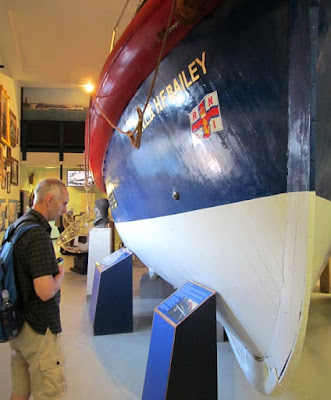 |
| A quiet day in Cromer, England |
Nevil Shute's 1928 novel So Disdained (published as The Mysterious Aviator in the United States) introduces us to a former World War I pilot named Lenden. In the novel, he tells the narrator, Moran, of a seaside flying venture he and his fellow pilots ran. They traveled around England, and spent weekends in seaside tourist towns. They offered people there short ten minute rides in their Avro seaplane. For 1919, such an opportunity would be a radical change of pace for your average tourist. Aviation was in its infancy then, and the idea of affordable long distance travel aboard airplanes little more than a fantasy.
For Lenden and his partners, getting close enough to the beach to load and unload passengers at a seaside town like Cromer would mean battling those strong winds and ocean currents with the Avro's engine running. If the wooden beach walls were there a hundred years ago, Lenden and his pilot friends would have had to factor those barriers into their approach. All those difficulties limited their efficiency, and Lenden tells Moran that he and his partners never managed more than three flights per hour.
As if the normal difficulties of running the business weren't enough, consider what happened when an accident occurred. Battling the strong winds and ocean currents, and getting a lightweight airplane onto and off the shingle beach, meant regularly breaking one of the plane's floats, which shut down operations until they could buy and fit a new one. And it wasn't like airplane parts were readily available back then. While I'm sure Lenden and his associates would keep a certain amount of spares on hand, each time something broke, it took time to be fixed, which prevented customers from flying during that time. And then, another replacement part would need to be sent for.
After awhile, Lenden and his pals found that charging a guinea (one pound and one shilling) per person wasn't enough to recoup their costs, they upped the charge to thirty shillings (one-and-a-half pounds). Still, the work wasn't regular enough for them to make the business a going concern.
Nevil Shute worked as an engineer and a designer in the aviation industry. I'm assuming Shute knew the realities of such tourist airplane operations back then, and built those into Lenden's backstory. So I'm treating the fictional Lenden's description of the physical and financial plight of a seaside holiday plane operator as realistic. I'm assuming Lenden and his fellows charged a fair price, one that most holiday-makers could pay. Still, it wasn't enough to make their little airplane business a success.
I wonder what a guinea, or thirty shillings, was really worth back then. It certainly was worth more than a pound or one pound-fifty today. Then again, you can get a lot for a pound at a grocery store like Tesco's or Morrison's. For example, you could get a pack of chocolate digestive biscuits for a pound. Or you could get a roll of Jammie Dodgers for a pound. You could probably even get two Scotch Eggs for a pound--they make a great alternative to sandwiches! So even though I'm only an occasional visitor to England, I'd say the British pound still retains a good amount of purchasing power, in my opinion.
And then of course, there are always even more affordable stores like Poundland, where everything they stock is for a pound. Don't even get me started on everything I could buy there!
Dragon Dave








